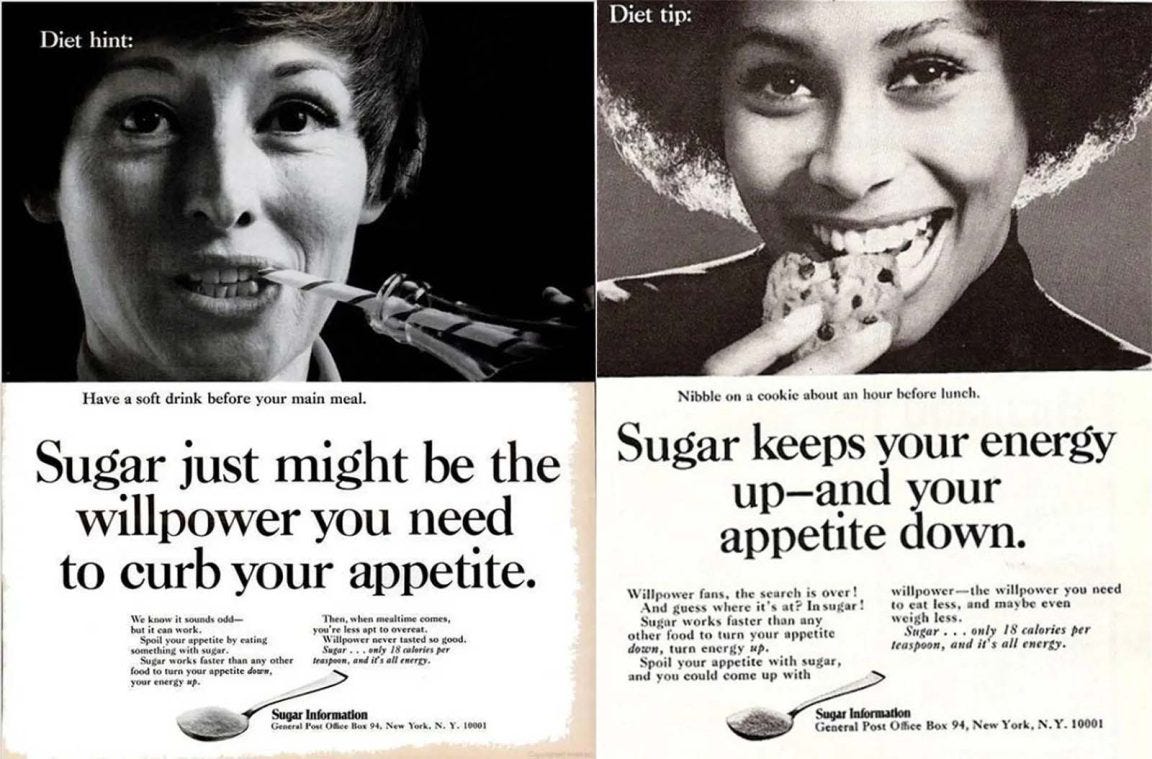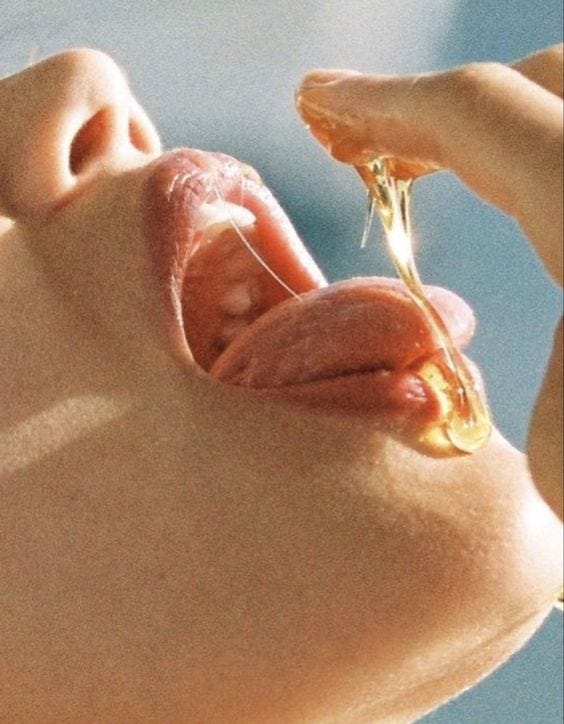The Decadent Diet is all about how the best tasting foods are the healthiest.
And what tastes better than sugar? That most polarizing yet desirable of foods—rare is the person alive today who eats sugar without guilt.
And yet, people from all walks of life for thousands of years have sought after sweet foods, and the people of Tan Land are no different.
Only recently have people started to fear sugar. Today, we will see how that fear has been misplaced, and instead discuss why sugar is a necessary and healthy part of the decadent diet.
In Defense of Sugar
Since the 1950s, people in the US have gotten fatter and fatter every year. That much is clear:
Everyone wants to be a healthy weight, so sugar’s supposed influence on obesity is an unforgiveable sin.
How much guilt and shame have we applied both to ourselves and others for eating these supposed “empty calories”?
It’s almost an instinctive reaction at this point. “Oh it has sugar? No thanks, I’m trying to lose weight.”
Of course, never free of the innate desire to taste sweet things, people have contrived all sorts of fake alternatives: aspartame, stevia, xylitol, allulose, erythritol, monk fruit extract— on and on.
And what have we gotten for all that effort?
Non-calorie sweeteners don’t decrease the overall amount of calories consumed. Stevia makes men infertile. Erythritol causes heart attacks. And obesity is still larger than ever.
But all the fear-mongering and marketing of alternatives has worked. People eat way less sugar than they used to:
But wait a second.
Do you see it?
Hint: scroll back up to the graph above.
That’s right— people are 3x fatter AND eat 25% less sugar than they did in the 1970’s.
It’s true that correlation doesn’t mean causation. But it’s also true that causation requires correlation. And here, there’s no correlation— it’s the opposite.
What this data says is that it is basically impossible for sugar in isolation to have caused the rise of obesity.
The less sugar we’ve eaten, the more we’ve gotten fat.
All the guilt, all the shaming, all the self-denial, and for what?
Maybe the fact that we desire it so much just might mean that there’s a good reason to eat it.
Human instincts
That’s exactly right. Your taste buds have evolved, like all other animals’, to make you desire what is good for you.
Every animal in its natural environment seeks the healthiest foods by taste. Anyone with a dog or cat knows this.
The problem is when artificial foods are introduced that hijack the natural taste-nutrient feedback loop.
But isn’t sugar artificial?
Sure, some forms of it are, and it is available in quantities that our ancestors would not have found. We will talk about healthy sugar consumption later.
But sugar is plentifully available in the wild. And where it is, healthy primitive humans like the Hadza tribe— free of obesity and diabetes— eat it up.

But honey is pure sugar! It will make you fat!
Sure. Sure it will.
Sugar is necessary both for the body and brain— it is commonly eaten by endurance athletes as well as chess players to keep performance up.
Human breast milk has more sugar than any other animal’s— arguably to fuel the massive brain growth required in early infancy.
And fructose causes less weight gain than glucose (the starch sugar).
But surely, all the research on sugar’s ills must account for something?
Indeed. Sugar seems to be a problem primarily and exclusively when people are also eating high amounts of PUFAs from seed oils.
Funny enough, seed oil consumption correlates perfectly well with the growth in obesity.
So if you stick to the Decadent Diet, which involves eliminating seed oils and most PUFAs, the “harmful effects” of sugar will be minimized.
How to eat sugar
“Okay we get it Tan Man, sugar doesn’t make you fat. But surely I shouldn’t just eat candy all day!”
Of course not. The foundation of every good diet is nutrient dense animal foods, as described in part 1.
As for sugar, the general rule is that the more you use your brain or your body, the more sugar you should eat.
The less you do those things, the less you should eat. Simple.
Sugar
Now that we know sugar as such doesn’t make us fat, we will discuss which forms of sugar are the best to eat.
Natural Sugars
The most abundant and obvious sugars in the wild, natural sugars can contain a host of beneficial minerals, enzymes, and micronutrients that only add to the experience.
Don’t get me wrong— they are still mostly sugar, and we are eating them because they contain sugar.
While these options are more ideal than refined sugar simply because of their additional benefits, actual sugar shouldn’t be feared.
Honey
Raw, local honey is available almost everywhere and it is amazing. The pollen in raw honey can help you overcome seasonal allergies too.
Because bees fly up to 3 miles from their hive (hypothetically into a neighbor’s yard), organic is sort of meaningless for honey.
Look for raw/unheated, unfiltered, and as local as possible. Some honeys will be tested for lack of pesticides, that’s great too.
Maple Syrup
Best used in situations where honey would have a hard time dissolving, or if the honey flavor is too strong. E.g., in coffee or liquid desserts. Pesticides are rarely used in maple farming, so organic isn’t a huge concern here.
Actual sugar
Organic sugar is ideal when nothing else will work, especially in baking. You can find other kinds of sugar— coconut sugar, beet sugar, maple sugar— but at the end of the day they’re all similar. No need to go crazy.
Sweet Fruits
While fruits may seem more “natural” than honey or maple syrup, the irony is that most fruits today have been selectively bred for sweetness.
Still, fruits are an amazing source of sugar, hydration, minerals, and vitamins.
Look for ones that are organic, and locally and seasonally grown if possible. I would personally avoid non-organic fruits, as they are among the most sprayed crops.
This naturally means you will eat the most fruit during the summer, which is fine. Sugar consumption should arguably be higher then anyway, since it supports a faster summer metabolism.
As with all foods, the deeper the color, the better.
Berries
Wild picked berries are ideal. Frozen berries are great, since they go bad quickly and keep very well when frozen.
Grapes, blueberries, raspberries, strawberries, you name it.
Citrus fruits
Oranges are personal favorite fruit. Citrus fruits do indeed have a lot of vitamin C, and I find they help with digestion.
Apples
Hard to find these completely organic. The tarter varieties are usually the least modified and best quality
Bananas/plantains
These cause indigestion for some people. They also have a lot of starch. I wouldn’t eat too many
Tropical fruits
Papayas, mangoes, pineapple, etc. These can be amazing if you find a fresh source, but most of them go bad by the time they get to the US. Unless they are very high quality, I wouldn’t bother.
Melons
These fruits can be delicious, but also contain somewhat toxic cucurbitacins which may cause discomfort depending on your gut health. See what works for you.
Jams/jellies
When made with organic fruit and no other crazy ingredients, jams are a great way to preserve fruit into the winter. You can make them yourself with gelatin and they last a long time.
Candies/Sweets
Despite sugar’s innocence, most candies that you can buy in a store are complete garbage.
Full of artificial food colorings, toxic fillers and additives, and weird unnatural flavors, candies are basically a no-go.
And because health people think sugar is bad, there have been very few attempts to make candies with good ingredients.
That being said, there are a few exceptions:
Chocolate
The chocolate renaissance has seen the development of some really great brands. Organic, fair trade, single origin, etc. chocolates are widely available and most have good ingredients
However, many chocolate companies have a vegan streak and can add weird ingredients instead of the milk that is present in normal chocolate
Good brands include Alter Eco, Hu, and Raaka chocolate.
Gummies
Gelatin comes from beef, and if you mix it with some fruit juice and maple syrup, it produces a delicious candy that is probably the best you’ll be able to get until the candy industry gets its act together.
Maple sugar candy
If you’ve never had it, try it. All I’ll say.
Desserts
This is a bit of an open-ended category. Now that you know sugar isn’t so bad, and given the dairy and grain options available in the previous parts of this series, you have everything you need to make most traditional desserts according to the time-honored dessert equation:
Dairy + sugar + fruit (optional) + grain (optional).
Just make sure to follow all the rules previously laid out. It is overwhelmingly unlikely you’ll be able to buy anything that meets these criteria, so best to make yourself.
Sample Meal Plan
It might still be unclear exactly how much sugar to eat if you are coming from the mindset that sugar = evil.
To make this as easy as possible, here is a rough overview of how I incorporate sugar into my diet.
If you pracice endurance sports, you might want to up the sugar. Otherwise, I think this is a decent starting point for most people.
It’s likely far less than the average american gets from sweet tea and kit kats, yet at the same time I never deprive myself. Guilt from eating is an unnecessary stressor on your life. I love what I eat and you should too.
I quit my job to help make the world a healthier place. Please consider becoming a paid subscriber of Tan Land to support my work and to gain access to my full archive of articles designed to help you live a healthier, more enjoyable life.
Keep reading with a 7-day free trial
Subscribe to Tan Land: Natural Health and Beauty to keep reading this post and get 7 days of free access to the full post archives.










